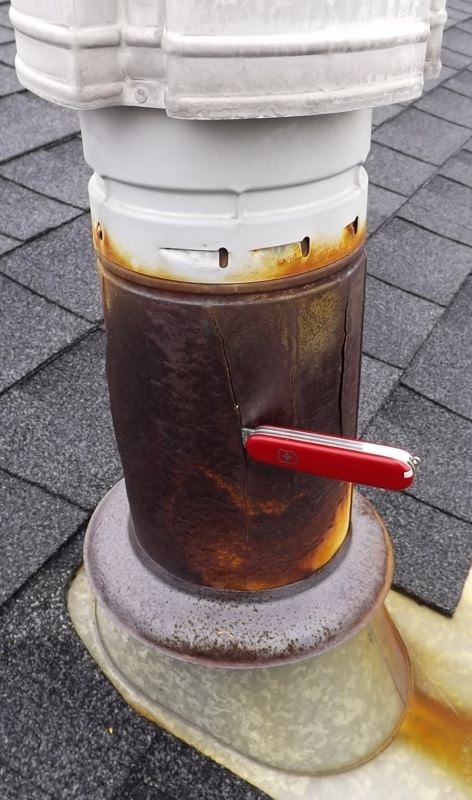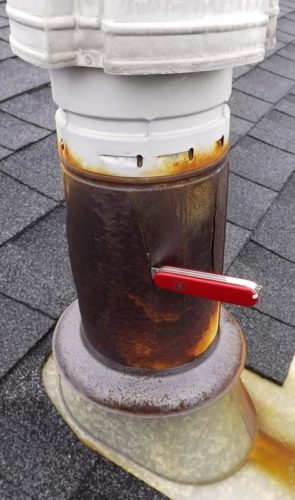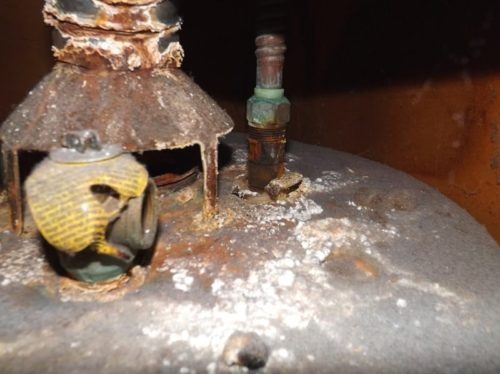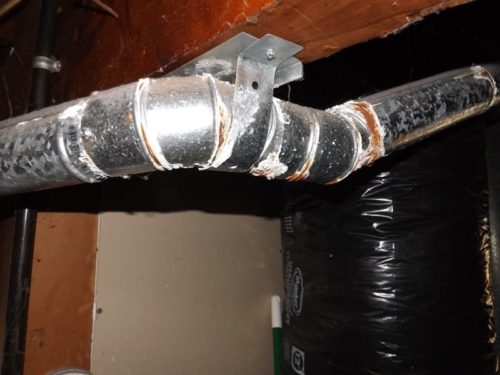
Back-drafting of water heaters is when the exhaust gases, instead of going up the vent and outside of the home, draft back into the space around the water heater. If the water heater is in the living space, this can mean that combustion by-products are ending up in the home. This is not just an issue with Carbon Monoxide, which is certainly a consideration, but it also can add large amounts Carbon Dioxide and  Moisture to the indoor environment. Additional water and carbon dioxide in the indoor environment adds another layer to our never ending battle with maintaining good indoor air quality. A properly burning gas water heater will only create carbon dioxide and water, so contrary to what many people believe, Carbon Monoxide is not “necessarily” going to be an issue. If this was not the case we could never use gas ranges in a home.
Moisture to the indoor environment. Additional water and carbon dioxide in the indoor environment adds another layer to our never ending battle with maintaining good indoor air quality. A properly burning gas water heater will only create carbon dioxide and water, so contrary to what many people believe, Carbon Monoxide is not “necessarily” going to be an issue. If this was not the case we could never use gas ranges in a home.
There are several causes of back-drafting–some of which will likely lead to Carbon Monoxide production and some less likely. Insufficient air supply to the heater can result in Carbon Monoxide production and then if we add to that improper installation of the vent (very long horizontal runs in relation to the vertical run of the vent for example), and obstructions in the vent, Carbon Monoxide loaded combustion by-products can enter the home. Add to this that Carbonic Acid (Carbon Dioxide in H2O) is created with faulty combustion/venting that will result in corrosion of metal components that come in contact with the vent gases.
When the water heater starts up, it is not uncommon for some amount of gases to back-draft out the draft hood as low temperatures in the flue are overcome. This is especially true of vents that share flues with other gas appliances–such as the furnace. We use water heaters year round, so a good part of the year the chimney can be considered over-sized for the water heater. Of course summer time flue temperatures are likely to be warmer than in winter so overcoming temperature differences in the flue/vent will not be quite as important a consideration. An argument can be made that all gas appliances should have their own vent or better yet that they should all be direct-vent type appliances. In some direct vent appliances combustion air and exhaust air by-pass each other from a location outside the home and there is no communication with the indoor environment.
Another way to create back-drafting at the water heater is when the improperly installed or blocked vent is shared with another gas appliance (such as a furnace) and the furnace vents back out through the water heater.
As homes become tighter and tighter, back-drafting can be created by any number of exhaust fans operating throughout the home when the water heater needs to operate. The path of least resistance for replacement of the air being exhausted by the fans might just be the water heater vent. So in this sense back-drafting can be an indication of insufficient makeup air for the exhaust fans and likely means the water heater does not have adequate combustion air as well. Making sure that homes stay “pressure neutral” so that these types of problems don’t occur is essential in modern construction. Again direct vent appliances can eliminate this problem as related to the appliances–but it will not solve the problem of air intake for the exhaust fans.
Atmospheric pressures differences such as during inversions can also contribute to poor venting of the gas appliance.
A proper vent hat is also an important part of the whole venting system in promoting proper venting by keeping vermin out and preventing wind from blowing down the pipe under some condition. It is not uncommon to find these vents filled with wasp’s nests—especially on systems that are idle for long periods of time.
So what does back-drafting look like? It is hard to actually see, but the results of its presence can be dramatic.
The following picture is of some extreme back-drafting.

If you look closely at the picture you can see all the signs. Notice the yellow tag all melted around the Temperature Pressure Relief Valve (TPRV—and, for all of you that know better, yes it’s drain pipe is missing). Notice how the galvanization has completely been eaten away on the supply nipple at the center of the picture. Notice the melted plastic ring around that same pipe. Keep in mind that the exhaust gasses are slightly acidic, which accounts for the corrosion visible on the draft hood (the cone shaped device behind the TPRV). The white powder on the top of the tank is the condensate that develops when the moisture from the vent gases evaporates.
In this next picture we can see some of the corrosion on the vent pipe along the long horizontal run to where it connects to the furnace vent. In this case the horizontal run is almost as long as the vertical run—not a good arrangement to promote good venting of either appliance. Also it should be mentioned that the single wall vent pipe does not have adequate clearances to the wood beam it travels under.

It will likely not be possible for your inspector to identify all the possible causes of back-drafting, but its presence gives itself away pretty easily in many cases. Because of the ease with which conditions for back-drafting can develop, items that can burn or melt should never be left on top of your gas water heater. I routinely find charred and melted belongings on top of gas water heaters–from soccer shoes to the water heater’s installation manual (very common).
I like to think that in a few years this blog post will be outdated, as we give up on draft hood type water heaters and convert entirely to direct vent type water heaters of one kind or another. We will be all the safer for it.
By Charles Buell, Real Estate Inspections in Seattle
If you enjoyed this post, and would like to get notices of new posts to my blog, please subscribe via email in the little box to the right. I promise NO spamming of your email! 🙂


